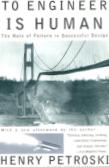To Engineer is Human: The Role of Failure in Successful Design by Henry Petroski
This is a great book to remind us of the purpose of engineering and the dangers we face when designing technical bridges (and physical ones) across the unknown.

Petroski wrote this in the early 80’s and the examples and illustrations are sometimes dated but still practical. I found the section on computers, “From slide rule to computer” to be particularly interesting. His case still hold true for the faster/newer techno-driven culture of the 21st century.
We have come to be a society that is so quick to change that we have lost the benefits of one of mankind’s greatest tools–experience. – Henry Petroski
Engineering is very dependant upon feedback for improvement. The goal of providing a design solution for the lowest cost will mean that materials, processes and other costly items will be minimized to achieve the most economical/efficient solution. Unfortunately, there are things that we do not know about (the trite, “we don’t know about what we don’t know” phrase comes to mind) that can be or become significant issues in the design. The Tacoma Narrows Bridge is a great example of this.
Engineering attempts to introduce “safety factors” into the design model to cover for the unknowns but this can often be inadequate, as was the case of the walkway collapse at the Kansas City Hyatt Regency Hotel.
Failures, while unfortunate and often deadly, should also be opportunities for improvement. Petroski argues that it is important that details of failures be broadcast to provide corrective feedback to all engineers so that future designs will build on these learnings.
